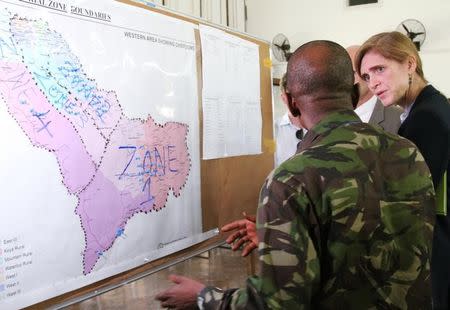Liberia sees results in Ebola fight but long way to go - U.S. envoy

By Michelle Nichols MONROVIA (Reuters) - Liberia is beginning to see results from international help to fight Ebola as the number of safe burials increases and laboratory testing times drop from five days to five hours in a remote area, freeing up treatment beds, U.S. envoy Samantha Power said on Tuesday. Power, the U.S. ambassador to the United Nations and a member of President Barack Obama's Cabinet, arrived in Liberia on Tuesday after visiting Guinea and Sierra Leone to assess what more the world can do to help Ebola-stricken West Africa. "We have a long way to go, we're on the right track, the rest of the international community needs to dig deep and step up and make contributions ... but we will stand together and we will defeat this epidemic," Power told a joint news conference with Liberian President Ellen Johnson Sirleaf in the capital, Monrovia. Power said safe burials were occurring at a much higher rate than the early months of the crisis. In neighboring Sierra Leone, the number of safe burials of Ebola victims has tripled in the past week in the capital Freetown. The bodies of Ebola victims are highly contagious and must be handled carefully. Power visited Bong County, about 200 km (120 miles) east of Monrovia, where the United States has set up a mobile laboratory and an Ebola treatment unit, which the U.S. Agency for International Development said is the first operational facility outside Monrovia. U.S. Navy Lieutenant Commander Benjamin Espinosa, the officer in charge of the laboratory, told Power that since the lab became operational three weeks ago, it had tested some 280 samples and in that time the share of positives had dropped to a third from half. He said this showed an increase in awareness among Liberians of Ebola's symptoms, which can be mistaken for malaria. Testing times have decreased to five hours from five days because samples no longer have to be transported to Monrovia. "While those five days were passing, Liberians were just waiting to know their fate, and that meant that people with Ebola were intermingled with people who might have malaria or some other ailment," Power said. She said the swfiter testing "allows people who do not have Ebola to move out of Ebola treatment units (isolation wards) and others who may be at risk to move in." Power also toured a converted 25-bed U.S. military hospital staffed by the U.S. Public Health Service in Monrovia, which opens in the next two weeks and will be used just to treat international and local healthcare workers who become infected. Several U.S. states have imposed a mandatory quarantine on returning healthcare workers, and Australia has implemented a ban on visas for the three worst-hit countries. Sirleaf Johnson appealed to those countries to view Ebola as a "global threat." "Stigmatization, exclusion, restriction is not the appropriate response to this," she told reporters. "We would like for them to recognize the progress being made by all the affected countries and be able to join in the partnership to make sure there's full containment of this." Some 5,000 people have been killed by the hemorrhagic fever, predominantly in Sierra Leone, Liberia and Guinea. There have been a handful of cases in Senegal, Nigeria, Mali, Spain and the United States. The disease is spread through contact with bodily fluids of an infected person or someone who has died of the disease. Power warned that the fight against Ebola in West Africa was far from over. "The plan is right, the resources are flowing in; it's implementation now that is the key, and the only results that matter are not how many ETUs (Ebola Treatment Units) you have or how many beds or how many health workers, it's whether or not Ebola ends ... in Liberia, Guinea and Sierra Leone," she said. (Reporting by Michelle Nichols; Editing by Jonathan Oatis)

